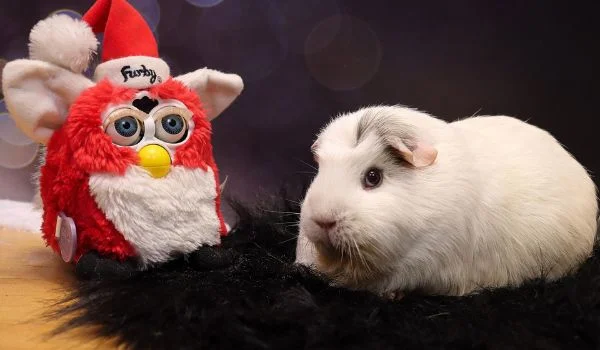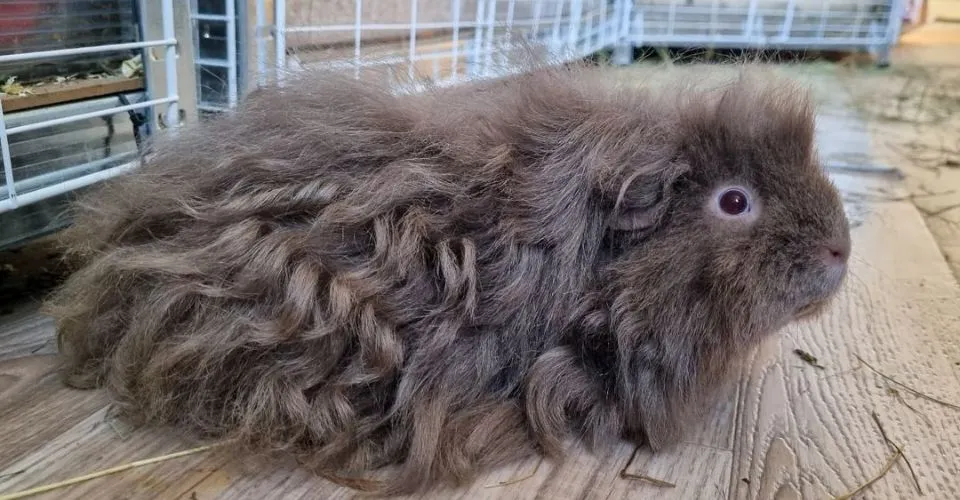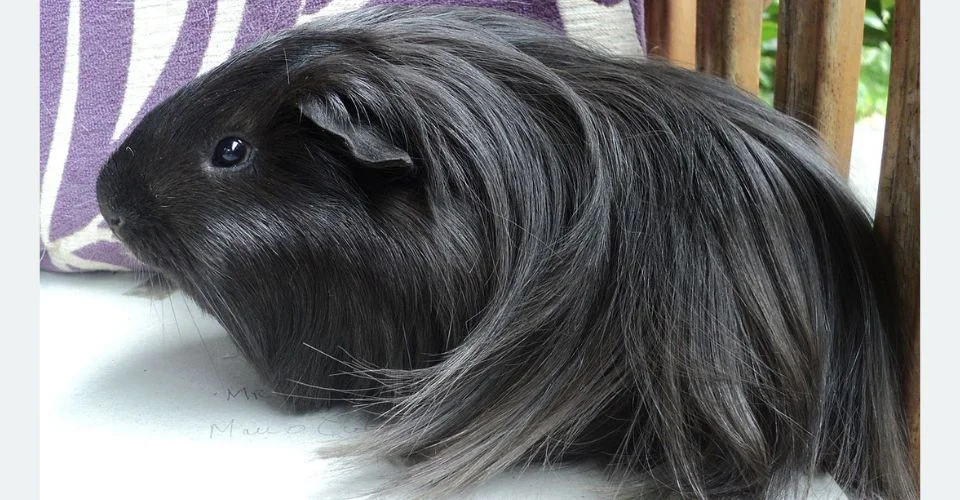Known as the Siamese cats of the guinea pig world, Himalayan guinea pigs are all white with black or chocolate color points. They are born all white, but like Siamese cats, they develop brown or black color points on their nose, ears, and paws as they age. They have a short hair coat, which requires very little grooming, making them a perfect pet guinea pig for children.
Have you been looking for a pet guinea pig? Perhaps you are bewitched by Himalayan guinea pigs’ white coats and red eyes and now want to bring one home. Well, before you go ahead and get a pair of Himalayan guinea pigs, you should first familiarize yourself with the personality and temperament of Himalayan guinea pigs and only bring them home if you think they make a good fit for you.
Himalayan Guinea Pig

Himalayans are albino guinea pigs with white fur with brown or black color points and pink to red eyes. Himalayan is one of the rarest and widely sought-after guinea pig breeds. They have a shorthaired coat and thus are relatively low maintenance. Himalayan cavies are incredibly social and curious little creatures, making them a great fit for children and first-time pet owners.
If you are thinking of bringing a Himalayan guinea pig, you should continue to learn all about Himalayan guinea pigs. Let’s start with a quick breed overview before getting into the deets.
| Himalayan Guinea Pig Breed Overview | |
| Scientific Name | Cavia porcellus |
| Common Name | Himalayan Guinea Pig |
| Origin | South America |
| Length | 8 to 10 inches |
| Weight | 1.5 to 2.5 lbs. |
| Lifespan | Up to 8 years but most live for 4 to 5 years |
| Coat Color | White with brown or black colorpoints |
| Maintenance | Low-maintenance |
| Diet | Herbivores (timothy hay) |
| Cage | At least 30×60 inch enclosure |
| Ideal temperature range | 65° F to 75° F |
| Temperament | Sociable, friendly, inquisitive |
| Suitable for | First-time pet owners, children and adults |
| Himalayan Guinea Pig Scoreboard | |
| Friendly | 4.5/5 |
| Like to be held | 4/5 |
| Grooming Requirements | 3/5 |
| Energetic | 4.5/5 |
| Good with other Guinea Pigs | 5/5 |
| Good with Children | 4.5/5 |
| Health | 4/5 |
Himalayan Guinea Pig History
Because of its name, many people believe that Himalayan guinea pigs come from the mountainous range of Himalaya in Asia, but it is not the case; like other most other guinea pig breeds, Himalayan guinea pigs also originate from the Andes region of South America.
You must be wondering that if Himalayan guinea pigs don’t come from Asia, then why they are named so. Well, they are probably named so because of their sheer resemblance to Siamese cats, which hail from Southeast Asia. They are recognized as a distinct guinea pig breed by the British Cavy Council.
Guinea Pig Personality and Temperament
Like most guinea pig breeds, Himalayan guinea pigs are incredibly social, friendly, and inquisitive creatures. They thrive in the company of their cage mates and also love to interact with their loving owners. Instead of pushing yourself onto your piglet, you should wait for them to warm up to you. Once they do that, they would not love being handled but enjoy being petted, smacked, sleeping in your lap and climbing up your shoulders.
Given their curious nature, Himalayan guinea pigs love to explore new spaces. It is advised that you keep them in pairs in spacious cages. Himalayan cavies are not really aggressive animals, but they might bite you if they are overhandled, frightened, hurt, sick, or startled. Guinea pigs may also bite your fingers if they smell of their favorite fruit or veggie. Read Why Do Guinea Pigs Bite? to learn what could be the reason underlying guinea pig biting.
Himalayan Guinea Pig Appearance
Born all white, Himalayan guinea pigs are albino cavies that develop color points on their nose, ears, and feet in the first few months. These color points and red eyes are the essence of Himalayan guinea pigs and make them one of the most desirable guinea pig breeds. At shows, they are exhibited in two different colors:
Chocolate Himalayan Guinea Pigs have a pure white body with sharply defined, dark pink to chocolate-colored ears, smuts, and pads. However, the most desired shades are jet black and rich milk chocolate. They Have bright red eyes.
Black Himalayan Guinea Pigs have a bit ‘crispier’ white body than Chocolate Himalayan guinea pigs. Instead of chocolate color points, they have black color points. Some Black Himalayan guinea pigs’ smut and feet may appear brown, which could be confusing. But if you look at their ears, they would be black, preventing confusion with Chocolate Himalayan guinea pigs.
Himalayan Guinea Pig Size
Himalayan guinea pigs are average-sized guinea pigs. A fully grown Himalayan guinea pig is about 8 to 10 inches in length, weighing between 1.5 lbs. to 2.5 lbs. Like other breeds, Himalayan guinea pigs don’t have a tail. However, they have broad shoulders and tend to be overall stockier than other guinea pig breeds.
Himalayan Guinea Pig Coat
Himalayan guinea pigs have a short hair coat, which is pure white at the time of birth, but as they age, they develop black or brown pigments on their nose, ears, and feet. While some guinea pigs develop the color point in a matter of 3 weeks, others may take even up to 3 months. The development of color points is dependent on the temperature.
Himalayan guinea pigs may even develop body pigment if the weather is too cold. On the other hand, the color points, especially the nose and feet, may start to fade if it is too hot. While a few white hair in the point is not penalized, white patches in points may lead to disqualification at shows. Besides that, unpigmented toenails and footpads may also result in specific disqualifications.
How to Care for a Himalayan Guinea Pig?

Caring for a Himalayan guinea pig is a not a massive task. They have short coat and thus don’t require very little grooming. So, you can easily keep your Himalayan guinea pig happy by housing them in a spacious and clean cage, feeding them on time, and brushing them every other day.
Feeding Himalayan Guinea Pigs
Himalayan guinea pigs have no special dietary requirements. So, their diet would be similar to those of other guinea pig breeds.
Guinea pigs are herbivores, so all they eat are plants. The Guinea pig diet primarily consists of hay (Timothy hay or Orchard hay), guinea pig pellets, and fresh fruits and veggies. Note that not all fruits and veggies are safe for guinea pigs, so before you feed your guinea pig with certain fruit or veggies, you should first make sure that it is not toxic to them.
Like other guinea pigs, Himalayan guinea pigs are also not able to make their own vitamin C. Therefore, you should ensure that there is ample in your guinea pig diet. Vitamin C present in guinea pig pellets breaks down with time. Therefore, make sure that you are providing fresh pellets to your piglet. You can also offer vitamin C supplements to your guinea pig to ensure that they never suffer from its deficiency, which could lead to the development of scurvy.
Some guinea pig-safe veggies rich in vitamin C include bell peppers, thyme, parsley, kale, broccoli, brussels sprouts, mustard greens, cucumbers, etc. While feeding veggies to guinea pigs, you should keep in mind that moderation is the key—eating in excess could cause tummy troubles, such as broccoli and brussels sprouts leading to bloating, making guinea pigs fart excessively. Instead of feeding veggies to your guinea pig, you should feed them a cup of mixed veggies.
While veggies like cucumber and kale are brimming with water and help keep guinea pigs hydrating, you should also ensure constant access to fresh drinking water. You can either put water in a bowl or provide it through a guinea pig water bottle.
Grooming Himalayan Guinea Pigs
Himalayan guinea pigs have a shorthaired coat, which means they require very little grooming compared to longhaired guinea pigs. Brushing their coat twice or thrice a week would be more than enough to maintain Himalayan guinea pig coat health. Besides, you will also have to bathe your guinea a few times a month when they get themselves dirty.
Guinea pigs might be excellent swimmers buy they hate water. They actually hate getting wet as they get wet to their skin and then get cold. On the other, guinea pigs may also risk suffering from overheating during the process of drying. So, you should only bathe your guinea pigs when it is absolutely necessary, and before putting your piglet into the bathtub, you should give our Guide on How to Bathe a Guinea Pig? a read.
Besides brushing and bathing, you will also have to trim your guinea pigs’ nails regularly and if needed trim their hair. You will also have to occasionally clean the pads of guinea pigs.
Housing Himalayan Guinea Pigs

While selecting a cage for housing your Himalayan guinea pigs, you should keep in mind that the bigger, the better—bigger in the sense of the floor space. Guinea pigs don’t really jump or climb, so you don’t have to worry about the height of the cage. However, as the tiny feet of guinea pigs might get stuck on the wiry floor of the cage, you should make sure that the cage has solid flooring. If you are housing two Himalayan guinea pigs, the cage should be at least 7.5 to 10.5 square feet.
Himalayan guinea pigs often get very skittish and scared and need a place to hide. Therefore, you must put multiple guinea pig hides in the cage. Besides that, you will also have to provide separate food and water bowls or bottles for each guinea pig.
Substrate For Himalayan Guinea Pigs
Given the trademark white coat of Himalayan guinea pigs, dyed beddings should be avoided. Similarly, you should never put newspaper in Himalayan guinea pig cage as it might discolor their beautiful coat. Cedar and Pine wood shavings should also be avoided as they can cause respiratory issues in guinea pigs.
The best substrate for Himalayan guinea pigs would be paper beddings devoid of dyes. These paper beddings would absorb the guinea pig urine and let them keep their aristocratic coat clean and tidy all the time. For premium results, you should consider getting guinea pig pee pads. But using pads, you will have to look out for guinea pig eating pee pads.
Himalayan Guinea Pig Health
Himalayan guinea pigs are overall a healthy breed, but like other guinea pigs, they are also susceptible to specific health issues. One of the most common guinea pig health issues is scurvy, which happens due to the deficiency of vitamin C. Providing Vitamin C supplements to your guinea pig would help keep scurvy at bay.
Besides scurvy, Himalayan guinea pigs are also prone to dental issues, urinary tract problems, bumblefoot, lice, conjunctivitis, diarrhea, etc. It is recommended that you never miss your regular/yearly vet visit.
How Much Does a Himalayan Guinea Pig Cost?
The average price of a guinea pig, regardless of its breed, is about $10 to $40. But given that Himalayan guinea pigs are a bit rare, you might have to pay up to $80. Given the rarity, you will have to do a bit of hustle to find a Himalayan guinea pig breeder. Cavy shows, clubs, and fairs will be a good start to find a Himalayan guinea pig.
While bringing home a Himalayan guinea pig, you should consider the cost of its upkeep. Besides the one-time cost of a guinea pig cage and other guinea pig supplies like hides, tunnels, hammocks, food, water bowl, etc., feeding and vet visits costs should also be kept in mind. The initial cost of housing a pair of guinea pigs could be anywhere from $150 to $500 or even more; the weekly cost of feeding and caring for a guinea pig is about $10. On top of that, vet visits, on average, cost about $30 to $80. If any serious health issues were to prop up, there might be additional costs of medications and medical procedures.
| Should You Get a Himalayan Guinea Pig? | |
| Pros | Cons |
| They are interactive and social creatures | Their pure white coat is prone to discoloration if a dyed bedding is used |
| They are overall healthy with a lifespan bit longer than most hamsters | They make a lot of noises, so they are not quite like rabbits |
| They are fairly easy to care for | They are rare and a thus a bit hard to find and costly |
Himalayan Guinea Pig Names
Naming guinea pigs could be really exciting and challenging at the same time. Well, if you have brought home a Himalayan guinea pig and now are having a hard time choosing a name. Here are a few names to boost you search for a perfect guinea pig name for your Himalayan.
| Himalaya | Pearl | Everest | Icecap |
| Snowflake | Angel | Casper | Ghost |
| Cloud | Smoke | Snowy | John Snow |
| Alaska | Misty | Sugar | Khaleesi |
| Lily | Frost | Nova | Diamond |
| Milkshake | Elsa | Coconut | Lace |
| Arctic | Ivory | Crystal | Luna |
| Ace | Cotton | Snowball | Spirit |
| Sunshine | Starlight | Storm | Star |
Naming your Himalayan guinea pig after one of the mountain peaks in the Himalayan range would be a great idea. Here is a list of a few mountains in the Himalayan range.
| Everest | Naga Parbat | Kamet | Yangra |
| K2 | Chomo | Kangkar | Gyala |
| Lhotse | Nanda | Manaslu | Lirung |
| Cho Oyu | nun | Dablam | Kangri |
| Makalu | Nuptse | Jomolhari | Kula |
Unable to find a fitting name?
Check out our guinea pig name treasures: Guinea Pig Names, Boy Guinea Pig Names, Girl Guinea Pig Names, and Cute Guinea Pig Names.
Interesting Facts About Himalayan Guinea Pigs
- They are neither from the Himalayas nor from Guinea. Instead, they hail from the Andes region of South America.
- They are albino guinea pigs as they are born with completely white fur, but as they age, they develop color points on their nose, ears, and paws.
- They will start developing color points by the age of 3 weeks, but some may take even up to 3 months to fully develop their color points.
- The development of color points can be controlled by controlling the temperature of their environment. If it is too cold, they might even develop pigmentation on their body, and in case the environment is too hot, the points on their nose and paws might start to fade in intensity.
- There are two varieties of the Himalayan guinea pig: Black and Chocolate.
- They have large bright red eyes.








